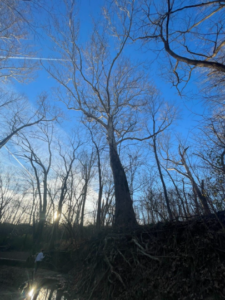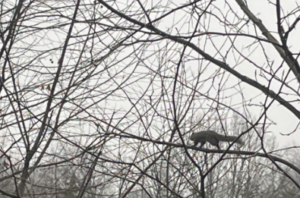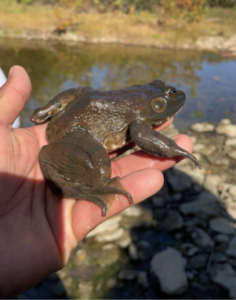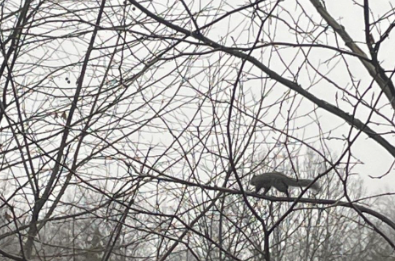Surviving the Cold Season at The Parklands
Writer / James F. Garner
Photography Provided
When the Louisville weather outside is frightful, snuggling inside with heat and hot drinks can feel so delightful. For our local wildlife, including those living in The Parklands of Floyds Fork, winter is much more manageable for them. Most wildlife have developed winter adaptations to help them survive the cold and obtain things like food, water and shelter. These can be physical characteristics or changes in behavior. To combat the lower temperatures and reduced access to food and water, animals and plants will go dormant, travel or become more resilient.
Catch some ZZZs
One way many animals survive the winter is by going dormant. Dormancy helps combat the cold and limited resources, by suspending normal physical functions or slowing down activity. Planning for dormancy is a potentially critical adaptation that animals will use to reduce their survival needs. They prepare by storing fat for insulation, and locating or building a hibernaculum (hibernating shelter) to rest. In addition, animals that store fat before hibernation may also depend on a food cache to intermittently feed themselves during winter. Hence, wildlife that depend on dormancy collect and store energy prior to and during winter to balance their energy output.
Because cold-blooded and warm-blooded animals have different internal functions, dormancy may be referred to as diapause or brumation for cold-blooded animals. For warm-blooded animals, dormancy is referred to as torpor or hibernation. This process slows their metabolic rate and reduces their body temperature. While many animals at The Parklands will reduce their activity levels during winter, groundhogs are one of the few true hibernators at the park. During hibernation, groundhogs rely on stored fat for energy while burrowing underground with leaves for insulation. During their hibernation, groundhogs lower their body temperature and slow their breathing rate, greatly reducing energy output and nutritional needs. Hibernation and brumation are important adaptations for warm- and cold-blooded animals to reduce their survival needs, remain warm and increase their chance to survive winter.
Plants are similar in that they cannot withstand harsh winter conditions for an extended period. Therefore, some plants will go dormant for winter. Perennial plants like deciduous trees spend most of the year collecting sunlight with broad leaves, which produce energy for the plant through photosynthesis. However, in preparation for winter, these plants will retract nutrients from the leaves and their above-ground structure, causing them to drop their leaves and concentrate on storing energy in the roots to survive winter. While in a dormant state, the tree will also halt its growth until spring. At The Parklands we primarily have deciduous trees in our forests like oaks, hickories, beeches and maples. However, with no leaves, this period is a great time for bird watching.
Are We There Yet?
Going dormant for a season can be effective for some plants and animals to cope with winter, but some animals just can’t tolerate the cold. For them, migration is an effective method to successfully survive the conditions of winter. Migration is seasonal movement to another habitat where food is available and conditions are more favorable. Animals that migrate require high energy levels as some migrations cover thousands of miles.
Monarch butterflies are one of these migrating species. As monarchs cannot survive freezing conditions, they travel south in search of warmth, which can take five generations to complete a full migration. As monarch butterflies make this journey, they lay eggs exclusively on the leaves of milkweed where, upon hatching, their larva will feed on those leaves. Once the larvae go through metamorphosis and become adults, the monarchs will continue the migrational patterns of their parents. However, larger animals like geese can accomplish their migrational journey many times over the course of their life. To aid in the endangered insect’s protection, The Parklands participates in a project called Monarch Watch each fall to support the monarch butterfly, by tracking their migration patterns and cultivating food for monarch larvae.
warmth, which can take five generations to complete a full migration. As monarch butterflies make this journey, they lay eggs exclusively on the leaves of milkweed where, upon hatching, their larva will feed on those leaves. Once the larvae go through metamorphosis and become adults, the monarchs will continue the migrational patterns of their parents. However, larger animals like geese can accomplish their migrational journey many times over the course of their life. To aid in the endangered insect’s protection, The Parklands participates in a project called Monarch Watch each fall to support the monarch butterfly, by tracking their migration patterns and cultivating food for monarch larvae.
Although plants do not move, they migrate themselves generationally. Plants that don’t have a strong resistance to cold will die during seasonal changes. Any plant species that can’t stand up against the harsh winter conditions rely on seed migration to return in the spring. Depending on the plant’s strategy, the seeds may migrate using wind, water, gravity or living animals. These plants concentrate their energy on creating seeds that are the best for their chosen migration so they can be re-established in the spring.
Bouncing Back
Plants or animals that don’t hibernate or migrate are more resilient to survive the conditions of winter. For animals, their resilience focuses on preparation, mobility or warmth. For plants, their resilience focuses on stability and efficiency.
While many reptiles rely on brumation to survive, some have developed additional traits to improve resiliency, like wood frogs and spring peepers. These species can freeze over during the winter months and thaw in the spring without consequences. Many mammals, like the gray squirrel, grow another layer of fur, eat more, and prepare food caches for the long winter. As winter conditions get harsh, these animals will depend on their protective shelters and food stores to survive until conditions are milder.
peepers. These species can freeze over during the winter months and thaw in the spring without consequences. Many mammals, like the gray squirrel, grow another layer of fur, eat more, and prepare food caches for the long winter. As winter conditions get harsh, these animals will depend on their protective shelters and food stores to survive until conditions are milder.
Plants that don’t rely on dormancy or seed migration have developed adaptations that support less access to sunlight and protection from heavy snowfall, high winds and freezing conditions. Woody plants like evergreens have adapted to winter through their triangular structure, which supports a strong foundation, keeping the tree rooted and reducing damage caused by high winds and freezing conditions. Along with its triangular structure, evergreen trees like pines equip themselves with needle leaves rather than broad leaves, which require fewer nutrients to maintain and allow these trees to retain leaves year-round. Maintaining their leaves is a big advantage for plants in winter as they can continue producing energy through photosynthesis.
What to Expect at The Parklands
While winter may feel challenging at times, it is truly a beautiful season and one that can be enjoyed at The Parklands of Floyds Fork. Come explore the wintery landscape and see if you can’t spot some plants and animals that are winter ready! The Parklands of Floyds Fork is open 365 days a year from dawn to dusk and is always free. The Parklands is a visitor-supported public park that does not receive tax revenue for operations. You can support The Parklands and all its plants and animals by donating to become a member, and gain access to exclusive events and discounts on park programs. Visit theparklands.org/membership or follow them on social media for more details and information on park events.





